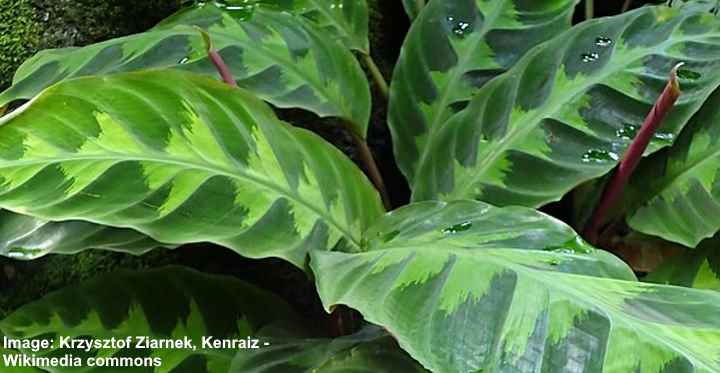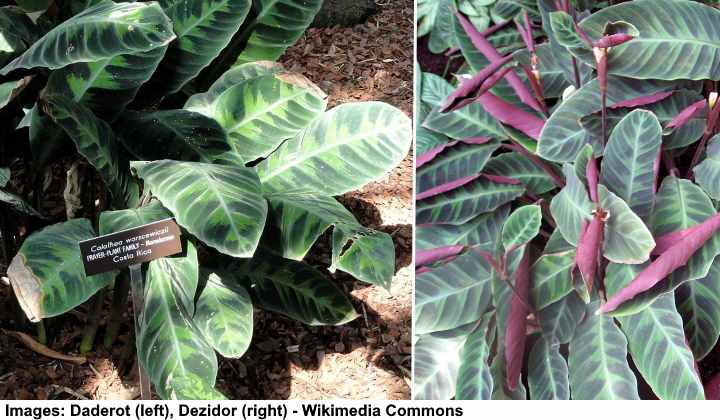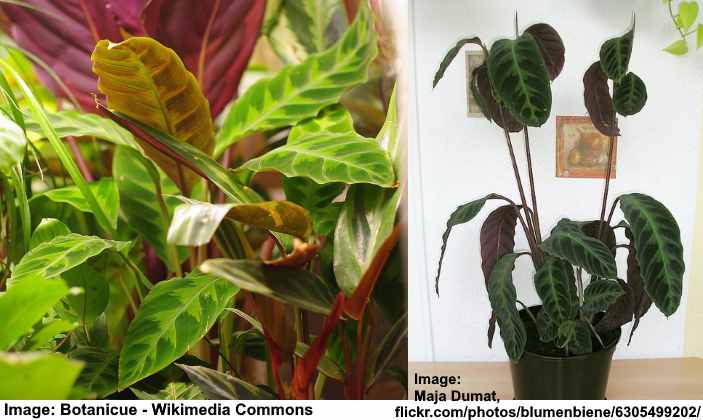Calathea Warscewiczii (Jungle Velvet Calathea): Care and growing Guide

The Jungle Velvet Calathea (Calathea warscewiczii) is a flowering tropical houseplant with soft velvety leaves. The beautiful leafy foliage features green patterns on the upper sides and purple undersides. This evergreen perennial plant thrives indoors with minimal care. Thanks to its smooth foliage and bushy appearance, the Jungle Velvet Calathea adds tropical greenery to any home’s interior.
The Jungle Velvet Calathea is one of the many Calathea plants that grow well in pots. Other spectacular varieties of Calathea include the Peacock Plant (Calathea makoyana), Calathea Medallion, and Network Plant (Calathea musaica).
This article is a complete guide to caring for the Jungle Velvet Calathea. You will also get helpful tips on resolving growing issues with the Jungle Velvet Calathea—for example, leaves that turn yellow or brown.
How to Care for Jungle Velvet Calathea
To care for Calathea warscewiczii, grow the Jungle Velvet plant in medium or bright indirect light. Plant the Jungle Velvet Calathea in loose, well-draining soil. Water the calathea when the potting soil partially dries. Keep the potted calathea in average room temperatures and humidity over 50 percent. Fertilize monthly during the growing season.
What is Jungle Velvet Calathea?

Calathea warscewiczii (Jungle Velvet Calathea)
The Jungle Velvet Calathea (Calathea warscewiczii) is an evergreen, broadleaf perennial plant in the family Marantaceae. This Calathea variety has green and burgundy leaves that close at night and open in the morning. Jungle Velvet Calathea grows between 20” and 40” (0.5 – 1 m) tall and wide.
Calatheas are tropical plants that grow in the shady floor of tropical forests. In their natural habitat, calatheas thrive in dim light, consistent warmth, and high humidity. Outdoors, calathea plants need to grow in temperatures of at least 60°F (15°C). The Jungle Velvet Calathea grows in USDA zones 10 through 12.
Jungle Velvet Calathea is in the same plant family as prayer plants (maranta plants). Calatheas also look like prayer plants and have similar growing habits. In the evening, their variegated leaves fold up as if to pray. Then in the morning, when it’s light, the leaves open again to reveal their fascinating patterns.
Botanists have now given the Jungle Velvet Calathea a new scientific name Geoppertia warszewiczii. However, this article uses the name that most people are familiar with—Calathea warscewiczii.
Jungle Velvet Calathea Leaves

Calathea warscewiczii leaves
Calathea warscewiczii plants have leaves with an underside that feel like velvet. The smooth, slightly fuzzy lanceolate leaves have beautiful fishtail patterns. On the upper side, Jungle Velvet Calathea leaves have shades of green and light green veins. The leaves’ undersides are dark maroon or purple color visible when the leaves close at night.
A noticeable feature of Jungle Velvet Calathea leaves is that they tend to curl into a tube. This curling growth habit usually happens if something’s not right with growing conditions. A lack of water or too much intense sunlight can make the leaves roll like a cylinder.
Jungle Velvet Calathea Flowers

Calathea warscewiczii flowers
Jungle Velvet Calathea is a flowering tropical plant. Jungle Velvet Calathea flowers are showy, cone-like clusters of flowers (inflorescences). The calathea flowers start an attractive creamy white color that looks like a rose from above. As they develop, the flowers turn yellow with hints of pink and open into showy floral displays.
Like most Calathea species, the Jungle Velvet Calathea rarely blooms indoors. Only if growing conditions are perfect will a potted indoor calathea produce flowers. However, the velvety green and maroon foliage of the Calathea warscewiczii is the primary reason to grow this tropical plant indoors.
Jungle Velvet Calathea (Calathea warscewiczii) Care Guide
To grow a Jungle Velvet Calathea indoors, the plant’s requirements are indirect light, average room temperatures, and medium to high humidity. So, keeping a potted calathea healthy requires proper watering techniques and getting soil consistency right.
Here is a detailed guide to growing Jungle Velvet Calathea houseplants.
Light Requirements to Grow Jungle Velvet Calathea Indoors

Grow Jungle Velvet Calathea houseplant in an indirect sunlight – leaves tend to darken when growing in the shade
Jungle Velvet Calathea grows best in medium to bright light if it’s protected from direct sunshine. The best location for a calathea potted plant is near an east- or north-facing window. With sun exposure to the south or west, you should ensure the calathea is in indirect sunlight.
Intense direct sunlight can bleach calathea leaves, making them pale and discolored. You may also notice that too much bright light can cause the leaves to curl up and look like burgundy tubes.
Partial shade is best for growing a Jungle Velvet Calathea during hot summer months. During winter, put the plant in a bright location so that it gets plenty of indirect sunlight.
The Jungle Velvet Calathea is a plant that grows in low-light conditions. Your leafy potted plant should survive well in rooms or offices that have little natural light. Because Jungle Velvet Calathea is a low-light, humidity-loving plant, it is an ideal plant for your bathroom. It’s good to remember that Calathea leaves tend to darken when growing in the shade.
How to grow Jungle Velvet Calathea outdoors: You can grow Calathea warscewiczii in the ground outside if you live in USDA zone 10 or above. Plant the leafy tropical calathea in dappled sunlight where the soil has excellent drainage. Ensure the earth is always moist but never soggy.
Additionally, you can take your potted calathea plants outdoors in summer if you live in temperate climates. Just remember to bring them back inside as soon as nighttime temperatures drop below 60°F (15°C).
The Best Soil for Growing Jungle Velvet Calathea
Jungle Velvet Calathea houseplants grow best in a loamy, peat-rich potting soil that has excellent drainage. Combine two parts peat moss and one part perlite for drainage to create the perfect growing medium for Jungle Velvet Calathea. Peat moss is ideal because it’s light and airy while holding enough moisture to hydrate the roots.
You can also use a commercial potting mix for African violets to grow a Jungle Velvet Calathea. You can also amend a regular houseplant soil by adding charcoal bits, pumice, orchid bark, or coco coir. These natural soil amendments increase drainage and make the growing medium more porous.
The key to getting the soil mix right for calathea plants is to prevent it from drying out entirely or becoming waterlogged.
How to Water Jungle Velvet Calathea
The time to water Jungle Velvet Calathea is when the potting soil partially dries. Wait until the top 1” (2.5 cm) of soil is dry. Thoroughly soak the potting mix until water drains from the pot’s drainage holes. Allow all the excess water to drip out before returning the plant to its favorite location.
It’s best to avoid watering calatheas on a set schedule. Typically, watering plants on a schedule results in overwatering tropical houseplants and results in root rot. Or, in the summertime, you may end up not watering the plant enough, and dry soil can cause leaves to turn brown or curl up.
To check if your Jungle Velvet Calathea needs watering, poke your finger in the soil. If the top layer is dry, then water the plant. If there is still some dampness, hold off watering for a few days.
Here are some handy tips when it comes to watering a Jungle Velvet Calathea:
- Hot temperatures cause rapid calathea growth, and the soil dries out faster, so water your plant more often.
- Moisture evaporates quicker from terracotta pots than from plastic ones.
- Always plant calathea and prayer plants in pots with drainage holes.
- Calathea plant growth slows down in winter, so you must water them less often.
Related reading: Guide to watering houseplants.
Temperature Requirements for Jungle Velvet Calathea
Calathea warscewiczii needs warm temperatures to thrive. Typical room temperatures between 65°F and 80°F (18°C – 27°C) are ideal. In winter, it’s OK if the air temperature doesn’t fall below 60°F (15°F). The critical factor when caring for calathea plants is to avoid sudden temperature fluctuations.
To keep your Jungle Velvet Calathea thriving, protect it from drafts or warm airflow. In winter, ensure that the plant pot isn’t near a hot radiator or a heating duct. In summer, to grow calathea houseplants, keep the tropical calathea away from cold air-conditioning air or drafts from open doors or windows.
Jungle Velvet Calathea Humidity Needs
A Jungle Velvet Calathea needs high humidity to grow indoors. Some plant owners say that calatheas are fussy because they grow best in at least 50 percent humidity. To mimic their tropical environment, you can use a room humidifier, sit the plant pot on a pebble tray with water, or group tropical houseplants together.
To make a pebble humidifying tray, you need some water, pebbles, and a deep tray. Cover the bottom of the tray with a layer of decorative stones. Pour in water so that it’s halfway up the stones. Place the calathea pot on the pebbles, ensuring the plant doesn’t sit in water.
Some people ask, should you mist Jungle Velvet Calatheas leaves? You can use distilled water to spray a fine mist over the leaves. However, the high humidity needs of a calathea mean that misting the leaves is rarely an effective solution.
Jungle Velvet Calathea Growth Rate
Jungle Velvet Calathea is an evergreen tropical plant with a moderately fast growth rate. In ideal conditions, the Jungle Velvet Calathea grows up to 3 ft. (1 m) tall. In lower light or the shade, the calathea has slower growth.
How to Fertilize Jungle Velvet Calathea
The Jungle Velvet Calathea isn’t a heavy feeder. To boost the plant’s nutrient levels, apply a diluted balanced houseplant fertilizer once a month during the growing season. A weak fertilizer solution applied occasionally lowers the risk of nutrient burn. Or you could use an appropriate organic fertilizer to boost a Jungle Velvet Calathea’s growth naturally.
Calathea plants are sensitive to over-fertilization. So, don’t apply fertilizer too strong or too often. It’s also a good idea to flush the soil every two or three months to remove any excess mineral salts.
Repotting Jungle Velvet Calathea
Repot a Jungle Velvet Calathea every two years in spring. Transferring the calathea foliage plant to a larger pot encourages growth. While repotting, you can also refresh the soil to replenish nutrients and check for signs of root rot. Use an appropriate potting mix for calathea and prayer plants.
Here are two handy tips when repotting a Jungle Velvet Calathea:
- Signs your calathea needs repotting include slow growth, roots poking out the pot, and water doesn’t drain as fast.
- Don’t plant calatheas in oversized pots, as it’s easy to overwater them.
Pruning Calathea warscewiczii Soft Velvety Leaves
The only reason to prune a Jungle Velvet Calathea is to remove old, decaying, or dying leaves. Use clean sharp pruning shears to cut off leaf stalks at the soil line. Getting rid of old leaves gives the plant more energy to grow new leaves and improve your plant’s appearance.
How to Propagate Jungle Velvet Calathea
Root division is the preferred way to propagate a Jungle Velvet Calathea. Calatheas have rhizome roots that you can divide into two or three parts. Carefully remove the calathea from its pot and wash the dirt off the roots. Look for clumps growing together where you can divide them.
Cut the clumps off the main plant using sterilized equipment. Plant each root section in a new pot with the appropriate potting soil. Water thoroughly and put in a location with medium to bright light.
Is Jungle Velvet Calathea Toxic?
The Jungle Velvet Calathea isn’t poisonous to cats, dogs, or other pets. The ASPCA lists plants in the family Marantaceae on its list of non-toxic houseplants.
Pests Affecting Calathea warscewiczii Growth
Common household bugs like mealybugs, scale insects, and spider mites can damage leaves and stunt growth of a Jungle Velvet Calathea. To get rid of houseplant pests, make a natural neem pesticide spray. Combine 2 tsp. neem oil and 1 tsp. liquid Castile soap with 1 quart (1 l) of water in a spray bottle.
Spray the neem oil solution liberally on the Jungle Velvet Calathea foliage once a week to get rid of pests.
To keep your Jungle Velvet Calathea thriving, it’s crucial to check it regularly for signs of houseplant bugs. Here is how to spot common calathea pests:
- Spider mites—Look for silky strands of web hanging from leaves or stems. These tiny pests also spin webs on the underside of leaves. Keeping your Jungle Velvet Calathea in humid conditions and plenty of moisture usually prevents spider mites.
- Mealybugs—These pesky bugs look like fuzzy white dots lurking underneath leaves. You can spot signs of mealybugs by a cotton wool-like substance on foliage and stems. Dab them with rubbing alcohol to kill mealybugs instantly.
- Scale insects—Scale on calatheas look like bumpy growths on stems. You may also notice sticky honeydew on foliage and sooty mold on the plant. Use rubbing alcohol or neem oil to get rid of scale insects.
Diseases Affecting Calathea warscewiczii Growth
Fungal diseases associated with root rot are the most common factor that affects Jungle Velvet Calathea. Overwatering or poor soil drainage typically causes roots to decay. In time, you may notice leaf spot or yellowing leaves that start to wilt.
The best way to prevent diseases from affecting a Jungle Velvet Calathea is to water it properly. The golden rule is to only water a calathea when the potting mix has partially dried.
FAQs — Growing Calathea Houseplants
Although a Jungle Velvet Calathea requires little maintenance, there are some signs that your tender tropical plant could be suffering. Here are some common issues with caring for calatheas and how to resolve them.
Why is my Jungle Velvet Calathea drooping?
Watering issues are usually the cause of drooping calathea growth. Overwatering or underwatering can cause the green leafy foliage to wilt and the stems to become weak. To resolve this problem, it’s vital to only water your plant when the soil partially dries.
How do I revive Calathea warscewiczii?
To save a Jungle Velvet Calathea from dying, it’s usually necessary to repot the plant. Root rot typically causes calathea to die. You should remove the calathea plant from the pot and inspect the roots for signs of decay. Trim off any mushy or soft roots. You can then repot the healthy part from the plant.
If the damage is severe and root rot is extensive, you may have to cut your losses and get a new plant.
Why is my Calathea not opening?
Calathea warscewiczii leaves open and close in response to light levels. Sometimes, calatheas growing in low light conditions never seem to open at all. To encourage the plant’s leaves to open, move the pot to a brighter location.
However, if the leaves are curled and look like tubes, there’s something that your Jungle Velvet Calathea doesn’t like. To get rolled up calathea leaves to open, check that you’re caring for it properly. A lack of soil moisture, dry air, or too much sunlight can result in calathea leaf curl.
Why does my Jungle Velvet Calathea leaves have brown tips?
A lack of humidity or over-fertilization usually causes brown tips on calathea leaves. To prevent more leaf parts from becoming brown and crispy, increase humidity and make sure the plant is getting enough water. It could be a good idea to flush the soil to remove any excess mineral salt buildup.
The only way to eliminate brown tips on Jungle Velvet Calathea leaves is to remove the entire leaf and stalk.
Why are the leaves on my Calathea turning yellow?
Yellow Jungle Velvet Calathea leaves are usually a sign that the plant’s roots are waterlogged. Calatheas require regular watering—but just enough to keep the soil slightly moist. Yellowing leaves appear when the roots sit in soggy soil, or the roots have started to rot. Hold off watering the calathea until the soil partially dries to help your stressed plant recover.
Related articles:
